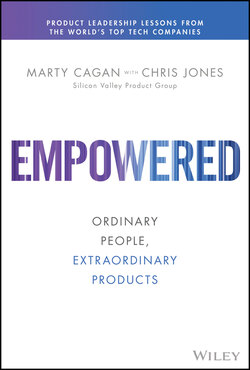Читать книгу EMPOWERED - Marty Cagan - Страница 21
ОглавлениеCHAPTER 6
A Guide to EMPOWERED
Who This Book Is For
This book is intended for anyone interested in creating a strong product organization—from a startup founder to the CEO of a major technology‐powered company.
Specifically, the book is aimed at product leaders and aspiring product leaders. Especially the leaders of product managers, product designers, and engineers.
When you see a reference to “product person,” that is normally anyone in product management, product design, or engineering. The person might be an individual contributor or a manager.
While there are many other roles you may find within a given product team—delivery manager, user researcher, data analyst, data scientist, and product marketing manager being the main ones—this book focuses on the three core roles of product manager (PM), product designer (designer), and engineering tech lead (tech lead).
When you see a reference to a “product leader,” that is normally a manager/director/VP/CPO of product management, manager/director/VP/CDO of product design, or a manager/director/VP/CTO of engineering.
Unless stated otherwise, the advice in the book is aimed at product leaders.
If some advice is aimed at a specific role, such as a product manager, product designer, tech lead, or data scientist, then this will be called out explicitly.
While there is some role‐specific information for product designers and their leaders, and engineers and their leaders, there is more information for product managers and their leaders. This is because, when moving to empowered product teams, the product manager role and the product management leadership role are usually furthest from where they need to be.
Who Is Speaking?
Unless otherwise noted, the author's voice is either Marty Cagan or Chris Jones. Both of us are partners at the Silicon Valley Product Group.
We don't call out which person wrote each chapter because we both agree with everything written here, and both of us were involved in the many iterations required to get from the first draft of each chapter to the resulting book.
Further, the lessons shared in this book are drawn from the broader set of SVPG partners. Between all of us, we have well over 100 years of experience leading product organizations at many of the top tech companies.
We are intentionally writing in the first person because we want to come as close as possible to the experience of sitting down with you, the reader, for a series of one‐on‐one coaching sessions, where our only goal is to help you become an exceptionally strong product leader.
How This Book Is Organized
So that you know the range of topics that are coming, here's an overview of the book:
In Part II, we focus on the most important responsibility of strong product leaders, which is coaching and development of the people on the product teams.
In Part III, we discuss staffing these product teams—how to identify, recruit, and onboard these people and ensure they are effective.
In Part IV, we discuss the product vision and principles, which define the future we are trying to create.
In Part V, we look at how we structure the product teams into a team topology that best meets the company's needs.
In Part VI, we discuss the product strategy, which is how we decide which are the most important problems for these product teams to solve.
In Part VII, we convert our product strategy into action through team objectives (problems to solve) for each product team.
In Part VIII, we provide a detailed case study that shows how each of these concepts plays out in practice in a complicated, real‐world situation.
In Part IX, we discuss how to establish the necessary collaboration between the product organization and the rest of the business.
In Part X, we tie everything together and give you a plan for transforming your organization to work the way the best teams and companies do.
While the type of change that is necessary is by no means easy, it is absolutely possible. This book is specifically designed to give you the knowledge and the skills you'll need to succeed.
